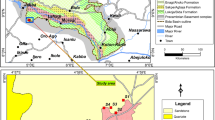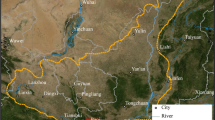Abstract
Many landslides have occurred at slope cuts-embankments adjacent to the Amman-Na'ur-Dead Sea and Irbid-Jerash-Amman highways in Jordan, especially during the last four years that were characterized by exceptional raifall during winter. Clayey beds found in the foundations of the failing areas were responsible for the occurrence of these landslides.
This paper presents the results of research evaluating the chemical and engineering properties of the clayey beds in the Kurnub Sandstone Unit and the Ajlun Group of the Upper Cretaceous at twenty four landslide locations along the Amman-Na'ur-Dead Sea and Irbid-Jerash Amman highways. The clay minerals associated with the clayey beds were characterized and correlated with their engineering properties. The relationship between clay minerals, chemical and engineering properties of clayey beds and the foundation failures were also identified.
The study included field visits to twenty four landslides sites to identify the problem, collect samples from the foundation along the slip surface, draw profiles and columnar sections.
Chemical analysis was carried out for the whole rock sample and for clay samples. Tests were also conducted to evaluate the physical and engineering properties of the samples.
Results showed that most of the landslides occurred within the upper part of the Kurnub Sandstone and the Na'ur formation.
Quartz, calcite and dolomite are the non-clay minerals and Mixed-Layer (I/S) and kaolinite are the clay minerals identified for samples obtained from the studied areas.
The jointed rocks allowed water to penetrate through the joints and reach the clayey beds. The ability of the mixed-layer (I/S) clays to expand in the presence of water resulted in the reduction of shear strength during rainfall, thus initiating the sliding process. The double-layer effect was noticed in samples with higher (I/S) content which gave the highest swelling potential, highest Liquid and Plastic Limits, and the lowest angle of friction.
Résumé
De nombreux glissements de tarrain se sont produits dans des déblais des autoroutes Amman-Na'ur-Mer Morte et Irbid-Jerash-amman en Jordanie, en particulier au cours des deux dernières années, qui ont été caractérisées par des chutes de pluie exceptionnelles en hiver. Les lits argileux présents dans les zones atteintes sont à l'origine de ces glissements. Le présent article présente les résultats des recherches sur les propriétés chimiques et géotechniques de ces lits argileux, à partir des prélèvements effectués sur 24 glissements. Les relations entre la nature et la quantité de minéraux argileux et leur comportement en place dans les glissements sont également étudiés.
L'étude inclut des visites de terrain sur les 24 sites, la collecte d'échantillons le long des surfaces de glissement, des profils et des coupes sériées.
Les analyses chimiques ont proté sur les échantillons globaux et sur les argiles.
Le quartz, la calcite et la dolomite sont les minéraux non argileux les plus répandus et les interstratifiés et la kaolinite sont les minéraux argileux rencontrés dans les secteurs étudiés.
Les roches fissurées ont permis à l'eau de pénétrer jusqu'aux lits argileux. Les niveaux à minéraux argileux interstratifiés ont gonflé réduisant la résistance au cisaillement durant les pluies, déclenchant ainsi le processus de glissement.
Similar content being viewed by others
References
AL-HOMOUD A.S., TAL, A. and HUSEIN (Malkwai) A.I., 1994a: “Instability and Stabilization of an Embankment on the Irbid-Amman Highway in Jordan”,Canadian Geotechnical Journal, vol 31, pp. 1015–1021.
AL-HOMOUD A.S., SAKET S. and HUSEIN (Malkawi) A.I., 1994b: “Investigation of Failure of Highway Embankment Founded on Colluvium and Suggested Stabilization Measures for Reconstruction”,Int. Journal of Engineering Geology, vol. 38, pp. 95–116.
AL-HOMOUD A.S., HUSEIN (Malkawi) A.I., BASMA A. and TAL A., 1995a: “Geotechnical Investigation of Embankment Foundation Instability and Landslide at Station 40+700 on Irbid Amman Highway, Jordan”, Africa Geoscience Review, Rock View Int., Vol. 2, No. 2, pp. 247–265.
AL-HOMOUD A.S., TAQIEDDIN S.A., SALAMEH E., TAL A.B., SAKET S. and SADOON M.I., 1995b: “A Critical Overview of the Geotechnical Studies at Na'ur Landslide No. 4 in Jordan: Causes and Measures”,Int. Journal of Engineering Geology, Vol. 40(1/2), pp. 103–136.
AL-HOMOUD A.S., TAQIEDDIN S. and SAKET S., 1975c: “Investigation on the Geological and Geotechnical Factors Leading to a Major Slope Failure at a Selected Site on a Jordanian Highway”,Natural Hazards Journal, Kluwer Academic Publishers, Vol 12, Dec. pp. 203–224.
AL-HOMOUD A.S., TAL A. and TAQIEDDIN S.A., 1997: “A Comparative Study of Slope Stability Methods and Mitigative Design of a Highway Embankment Landslide with a Potential for Deep Seated Sliding”, a Paper Accepted for Publication. Int. Journal of Engineering Geology, to Appear April.
American Standard for Testing and Materials (ASTM), 1983, “Annual Book of ASTM Standards, Section 4, Construction”, vol. 04.08, Natural Building Stones, Soil and Rock, American Society for Testing and Materials, USA.
BENDER F., 1974: “Geology of Jordan”, Supplementary Edition in English with Minor Revision, Gebr. Borntraegger, Berlin, 196 pp.
Dames and Moore International, 1993: “Landslides on Irbid-Jerash-Amman Highway”, a Report Submitted to Ministry of Public Works and Housing, Amman, Jordan, April.
DRISCOLL R., 1984: “The Effects of Clay Volume Change on Low-Rising Buildings”, Surrey University, Blackie Group, Glasgow.
GILLOTT J.E., 1986: “Some Clay Related Problems in Engineering Geology in North America”, Clay Minerals, vol. 21, pp. 261–278.
HAWKINS A.B., LAWRENCE M.S. and PRIVETT K.D., 1986: “Clay Mineralogy and Plasticity of the Fuller Earth Formation Bath”, U.K., Clay Minerals, vol. 21, pp. 293–310.
HORN H.M. and DEERE D.V. 1962: “Frictional Characteristics of Minerals”, Geotechnique, vol. 21, No. 4, pp. 319–335.
JULIO C.M., LUIS A.S. and LUIS M.B., 1992: “A Fortran Program for the Calculation of Normative Composition of Clay Minerals and Peletic Rocks”, Computer and Geoscience, vol. 18, No. 1, pp. 47–61.
MASRI M.R., 1963: “Report on the Geology of Amman-Zarqa Area”, Central Water Authority, Amman, 47 p.
MESRI G., ROKHSAR A. and BOHOR B.F., 1975: “Composition and Compressibility of Typical Samples of Mexico City Clay”, Geotechnique, vol. 25, No. 3, pp. 527–554.
McDONALD M., and Partners, In Cooperation with Hunting Geological Survey Ltd., 1965 “East Bank Water Resources”, Central Water Authority, Amman, Jordan.
MITCHELL J.K., 1976: “Fundamentals of Soil Behaviour” John Wiley, New York, USA.
MOHAMMED A., RABBA S. and OSSAMA M. 1981: “Role of Mineralogical Composition in the Activity of Expansive Soils”, Journal of the Egyptian Society of Engineering, vol. 19, No. 1, pp. 28–33.
OLPHEN H.V. and FRIPIAT J.J. 1979:Data Handbook for Clay Minerals and other Non-Metalic Minerals, Pergamon Press Inc., New York.
OLSON E. and MESRI G. 1970: “Mechanisms Controlling Compressibility of Clays, Journal of the Soil Mechanics and Foundation Division,” ASCE, vol. 96, No. SM6, pp. 1863–1878.
OLSON E., 1974: “Shearing Strength of Kaolinite, Illite and Montmorillonite”, Journal of the Geotechnical Engineering Division, vol. 100, No. GT11, pp. 1214–1229.
PARKER D.H. 1970: “The Hydrogeology of the Cenozoic Aquifers of the Western Highlands and Plateau of East Jordan (4 Vols.)”. UNDP/FAO 212 No. 2, Rome, 424 p.
Parsons Brinckerhoff International, 1987: “Amman-Na'ur-Dead Sea Landslide”, Report Prepared for Messrs Jouzy and Partners, Submitted to MPWH, Amman, Jordan.
QUENNELL A.M. 1951: “Geology of Mineral Resources of Trans Jordan”, Colonial Geology and Mineral Resources, London.
RAMANA K.V., 1993, “Humid Tropical Expansive Soils of Trinidad: Their Geotechnical Properties and Areal Distribution”, Engineering Geology, vol. 34, pp. 27–44.
REYNOLDS R.C. and HOWER J., 1970: “The Nature of Interlayering in Mixed-Layer Illite-Montmorillonite”, J. of Clays and Clay Minerals, vol. 18, pp. 25–36.
SHTEWI H., 1994: “Rythmic Sedimentation of the Marl-Limestone in the Upper Cretaceous of North Jordan”, M. Sc. Thesis Jordan University, Amman, Jordan.
SRIDHARAN A. and VENKATAPPA RAO G., 1973: “Mechanisms Controlling Volume Change of Saturated Clays and the Role of the Effective Stress Concept”, Geotechnique, vol. 23, pp. 359–382.
SRIDHARAN A., RAO S.M. and MURTHY N.S., 1988: “Liquid Limit of Kaolinitic Soils”, Geotechnique, vol. 38, pp. 191–198.
TAYLOR R.K. and SMITH T.J., 1986: “The Engineering Geology of Clay Minerals: Swelling, Shrinkage and Mudrock Breakdown”, Clay Minerals, vol. 21, pp. 235–260.
Author information
Authors and Affiliations
Rights and permissions
About this article
Cite this article
Al-Homoud, A.S., Khoury, H. & Al-Omari, Y.A. Mineralogical and engineering properties of problematic expansive clayey beds causing landslides. Bulletin of the International Association of Engineering Geology 22, 13–31 (1980). https://doi.org/10.1007/BF02600651
Published:
Issue Date:
DOI: https://doi.org/10.1007/BF02600651




